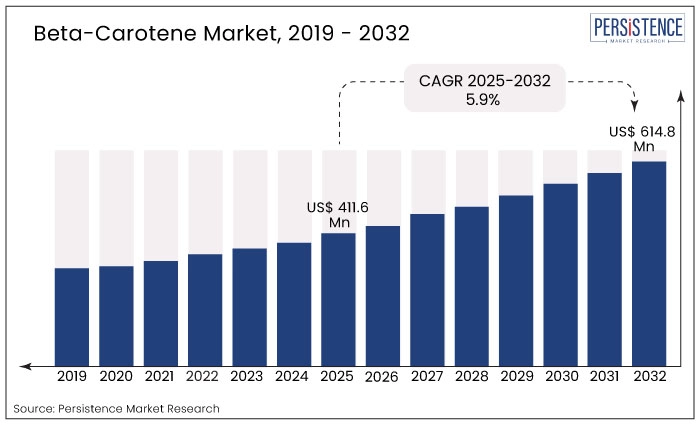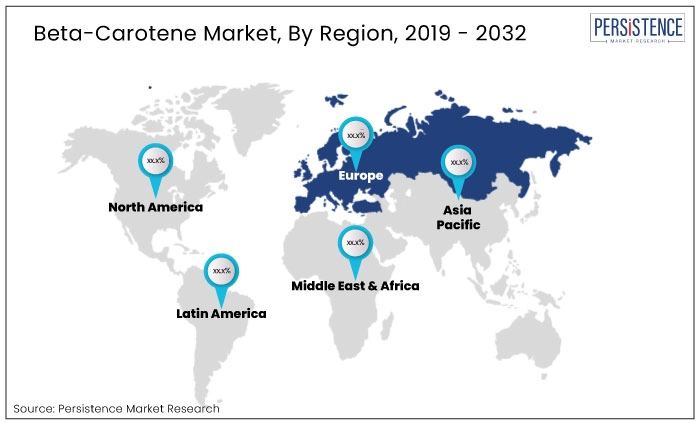ID: PMRREP33453| 315 Pages | 15 Jul 2025 | Format: PDF, Excel, PPT* | Food and Beverages

The global beta-carotene market is forecasted to expand at a CAGR of 5.9% and increase from a value of US$ 411.6 million in 2025 to US$ 614.8 million by the end of 2032.
More and more consumers are moving toward natural vitamin- and mineral-rich supplements, which is fueling the utilization of beta-carotene in the making of dietary supplements.
Beta-carotene is a natural pigment as well as a micronutrient that mainly occurs in yellow and orange fruits and vegetables. Beta-carotene is also known as provitamin A and contributes to vitamin A supply in the body.
The high content of antioxidant nutrients found in beta-carotene has caused a significant increase in its application in dietary supplements and pharmaceuticals in recent times. Beta-carotene, which is a naturally occurring compound responsible for the reddish-yellow coloration in plants, is also utilized as a food coloring agent in diverse food processing sectors such as beverages, packaged foods, and confectionaries.

| Report Attributes | Details |
|---|---|
|
Beta-Carotene Market Size (2025E) |
US$ 411.6 million |
|
Projected Market Value (2032F) |
US$ 614.8 million |
|
Global Market Growth Rate (2025 to 2032) |
5.9% CAGR |
|
Historical Market Growth Rate (2019 to 2024) |
4.4% CAGR |
|
Revenue Share of Top 4 Countries (2025E) |
40% |
“Rising Demand for Plant-Based Products Necessitating Increased Production of Beta-Carotene”
Rise of veganism and plant-based diets among consumers is boosting demand for plant-based products. Beta-carotene is a key ingredient in these products, providing a natural and plant-based source of color and nutrition. Plant-based products are often perceived as healthier and more sustainable than animal-based products, which further drives the demand for beta-carotene in these products.
Consumers are looking for plant-based products that are not only healthy and sustainable but also taste good, and beta-carotene can help enhance the flavor and appearance of these products. The shift toward plant-based products in the food and beverages industry is expected to boost the demand for beta-carotene as a natural colorant and nutritional ingredient.
“Increasing Preference for Natural Colorants over Synthetic Colorants”
Natural colorants are becoming more prevalent in the food and beverage industry as consumers become more aware of the adverse impacts of synthetic colorants.
Beta-carotene is a natural colorant that is in high demand due to its orange-red hue, making it ideal for various food applications such as beverages, confectionery, and dairy products. Use of natural colorants is becoming increasingly popular due to the rising awareness of the potential health risks associated with synthetic colorants.
Consumers are looking for healthier and safer alternatives to synthetic colorants, which is driving the demand for natural colorants like beta-carotene. Manufacturers also prefer beta-carotene as it is stable, easy to use, and cost-effective. Growing demand for natural colorants in the food and beverages industry is expected to boost the growth of the beta-carotene market.
“Technological Advancements in Beta-Carotene Extraction Processes Leading to Increased Product Availability”
Technological advancements in the extraction process have led to the development of innovative and efficient methods of extracting beta-carotene from natural sources such as carrots and algae. This has increased the availability of beta-carotene and reduced production costs, making it more affordable for manufacturers. There have been several technological advancements in beta-carotene extraction processes that have improved efficiency and yield.
For instance, enzymatic extraction methods have been developed that use enzymes to break down the cell walls of plant sources, allowing for easier extraction of beta-carotene. Supercritical fluid extraction (SFE) is a relatively new extraction method that uses supercritical carbon dioxide as a solvent to extract beta-carotene from plant sources. This method is more efficient, requires fewer solvents, and results in higher yields of beta-carotene.
“High Demand for Animal Feed Containing Beta-Carotene”
Growing demand for animal feed is one of the factors driving the growth of the beta-carotene market. Beta-carotene is used as a source of vitamin A in animal feed, particularly for livestock such as poultry, swine, and cattle. Vitamin A is an essential nutrient for animal growth and development, and beta-carotene is a natural source of vitamin A.
Use of beta-carotene in animal feed has been shown to improve the growth performance, reproductive efficiency, and immune function of animals, which brings in new opportunities for the growth of the beta-carotene market.
Growing demand for plant-based animal feed is expected to boost sales of beta-carotene. The trend towards natural and organic animal feed products is also expected to boost the demand for beta-carotene, as it is a natural and sustainable source of vitamin A.
“High Demand for Synthetic Beta-Carotene Because of Its Cost-effectiveness”
Synthetic alternatives to beta-carotene, such as synthetic vitamin A and synthetic carotenoids, can be more cost-effective and easier to produce than natural beta-carotene derived from fruits and vegetables. Synthetic beta-carotene is typically less expensive than natural beta-carotene, which can make it a more attractive option for manufacturers who are looking to reduce costs. However, synthetic beta-carotene may not be as bioavailable as natural beta-carotene and the body may not absorb it as effectively.
Synthetic alternatives to beta-carotene continue to be a competitive force in the market. Demand for natural and sustainable ingredients is growing, which may present opportunities for natural beta-carotene producers who can differentiate themselves in the market based on their quality and sustainability.
“High Demand for Personal Care Products with Organic & Natural Ingredients”
Germany, France, and the U.K. account for US$ 28.5 million, US$ 16.8 million, and US$ 27.3 million, respectively, in 2025.
Demand for beta-carotene from the cosmetics & personal care industry is anticipated to increase at 6.2% CAGR through 2032. This is because the customer base for organic and natural cosmetics in Europe is expanding, and manufacturers in Europe have started incorporating beta-carotene as a key ingredient in a wide range of personal care and cosmetics products.
“Increasing Utilization of Beta-Carotene in Food and Beverages Boosting Product Demand”
Demand for beta-carotene in China is anticipated to advance at a CAGR of 8.4% through 2032. This significant demand growth is due to the increasing usage of beta-carotene in food & beverage products such as carbonated drinks, sports drinks, and fruit juices across the country.

“Usage of Synthetic Beta-Carotene High in Food Processing & Animal Feed Due to its Stability”
Synthetically sourced beta-carotene is dominating the market and holds a 63.2% share of the market. This segment generates revenue of US$ 235.2 million in 2025 owing to a rise in its utilization in the food processing and animal feed industries. Synthetic carotenoids are more stable as they are specifically designed to reduce isomerization or oxidation.
“Utilization of Beta-Carotene in Personal Care & Cosmetics Industry Increasing Significantly”
The cosmetics and personal care segment is anticipated to exhibit significant growth, primarily due to increased usage of beta-carotene in skin care products such as sunscreens and whitening agents, as well as anti-aging face care products. The cosmetics and personal care segment is predicted to expand at a CAGR of 7% from 2025 to 2032.
Multinational companies that offer a diverse range of products constitute 45% to 50% of the beta-carotene industry.
Prominent players in this market include Koninklijke DSM NV, BASF SE, and Döhler GmbH, among others. These major manufacturers are focused on tailoring their product offerings for different applications, such as the food industry, cosmetic and personal care industry, and other sectors due to the versatility of beta-carotene. In terms of market share, regional players make up 50% to 55%, while local players account for 20% to 25% share of the industry.
By Source:
By Form:
By End Use:
By Region:
Global demand for beta-carotene increased at a CAGR of 4.4% from 2019 to 2024.
The global market for beta-carotene is valued at US$ 411.6 million in 2025.
Europe occupies a leading market share of 37.8% of the global market.
Sales of beta-carotene are projected to reach US$ 614.8 million by 2032.
Worldwide sales of beta-carotene are forecasted to increase at a CAGR of 5.9% from 2025 to 2032.
The U.S. market is valued at US$ 83.7 million in 2025 and is set to expand at 5% CAGR through 2032.
Rising demand for organic ingredients and increasing adoption of veganism are driving market growth.
Koninklijke DSM NV, BASF SE, and Döhler are some of the key producers of beta-carotene.
| Attribute | Details |
|---|---|
|
Forecast Period |
2025 to 2032 |
|
Historical Data Available for |
2019 to 2024 |
| Market Analysis Units | Value: US$ Bn/Mn, Volume: As applicable |
|
Key Regions Covered |
|
|
Key Countries Covered |
|
|
Key Market Segments Covered |
|
|
Key Companies Profiled |
|
| Report Highlights |
|
|
Customization & Pricing |
Available upon request |
Delivery Timelines
For more information on this report and its delivery timelines please get in touch with our sales team.
About Author